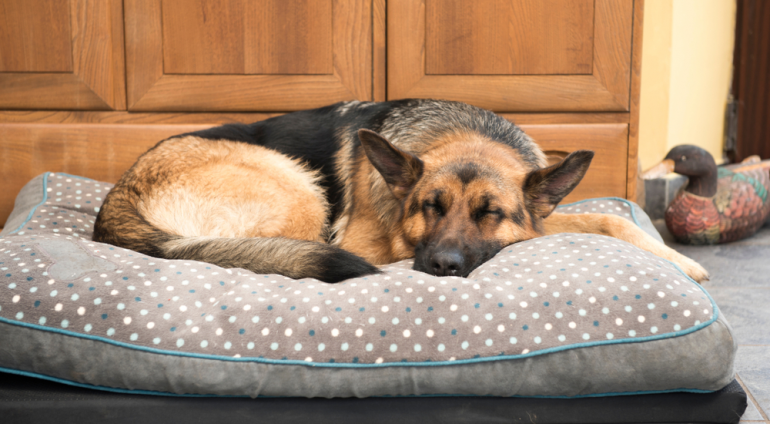A German Shepherd, or GSD for short, require slightly different beds than some other breeds, and depending on health issues and preference from the dog themselves you may be looking at a few different options. In this article, we will discuss the different types of beds, and which is the best dog bed for your GSD. Take a look at a few options, and find what you need for your own GSD.
Why are Beds Important?
Beds are important for a handful of different reasons.The first and most obvious is that it provides a place for your GSD to rest, and call their own.While some dogs may prefer to rest on tile floor or hardwood to cool off in hotter months, overnight sleeping will typically be done on their bed.They can also provide a feeling of safety and security for many dogs, as well as giving you an object to use during training.Some beds even offer addition effects, like gel beds keeping dogs cooler and orthopedicbeds helping with hips and joints for older pets.A bed that smells like a sibling or a parent can even be a boon to puppies who are leaving their mother, so having a bed for your dog is incredibly important.Below, we will go over a few different kinds of beds, and which to pick for your GSD.
Bed Types and Which Is The Best
-
Traditional Bed
The typical dog bed is a simple circle or oval shaped bed with a raised edge and typically a soft cushion in the middle.This bed is common for nursing mothers to keep their puppies under better control, or for dog who like to curl up with their back against something.These beds come in many different sized, but it is recommended you get a larger bed for your GSD.If you have a younger puppy or an adult who likes to curl up when they sleep, this is a good choice.Many of these come with a way to remove the outer cover, as well, allowing for machine washing in case of a puppy having an accident, or the bed becoming dirty with time.
-
Cushion/Pillow Bed
These beds resemble a simple, giant pillow or cushion that gives the dog a basic, soft place to lay down.Some of these beds can be just a single pillow without much else to them, and some can be thicker, better made cushions that allow for a dog to lay most comfortably on.If your GSD likes to stretch out when they sleep, or you want a bed that is easier to move, this bed is a great choice.Some younger puppies may see the cushion as something to chew on if they are teething, however, so it may be a better choice to find a more durable version of this bed.Kong makes some tougher beds for teething puppies and dogs who put more wear and tear on their beds.
-
Crate Mat
Crate Mats are thinner, much more simple beds that are typically only used in travel crates or for crate training.They are always thin and easy to move around, but may not provide as much support or comfort as a normal bed.While they are recommended or even required for lining your GSD’s crate, it is doubtful they will get much more use than that.One upside is that they are easily machine washable and cheaper than some beds, so for new puppies who may destroy a bed or soil it, they can make a quick, cheaper replacement instead of having to invest in multiple beds.
-
Orthopedic Beds
These beds are made of a more solid, form holding foam that is designed to help better support an older dog’s hips and joints.While usually more expensive than a regular bed, these beds are great for older dogs who are not as mobile as they used to be.For any GSD who has hip and joint problems, one of these beds can provide comfort and a sound night’s sleep, allowing for them to rest and recover better than normal bed.They do tend to be a bit more expensive, but the effects on your GSD are more than worth it.
So, Which Should I Choose?
While all of these beds have their own pros and cons, for larger breed puppies and dogs like the German Shepherd, you will want to select a larger bed.Looking at some of the physical attributes and health issues of the GSD, a puppy should be given either traditional bed to curl up in, or a large cushion bed if they like the sprawl out.It is recommended to give any puppy in a new bed a toy when they are first introduced to the bed, so that they can focus on chewing a toy instead of the bed.Once the puppy can sleep on the bed without trying to chew on it, praise can be given to them so they learn to leave it alone, and play with other things.
For an adult GSD, either of these beds will work just fine, once again depending on what the dog prefers or enjoys more.There is a much smaller chance of a well trained adult GSD chewing up their bed, so a higher quality bed can be given to these dogs.For a senior GSD, an orthopedic bed is almost always recommended, as the purebred GSD is known for having severe joint issues later in life.These beds will help your GSD feel more comfortable if they have begun to feel the effects of hip dysplasia, or their joints have become worn down.
Depending on the age and health needs of your GSD, different beds may be needed as your GSD gets older.As the needs of your GSD change, so should where they sleep, and what they sleep on.Be sure to shop around and find the best bed for your GSD in order to give them a happier, healthier life.

